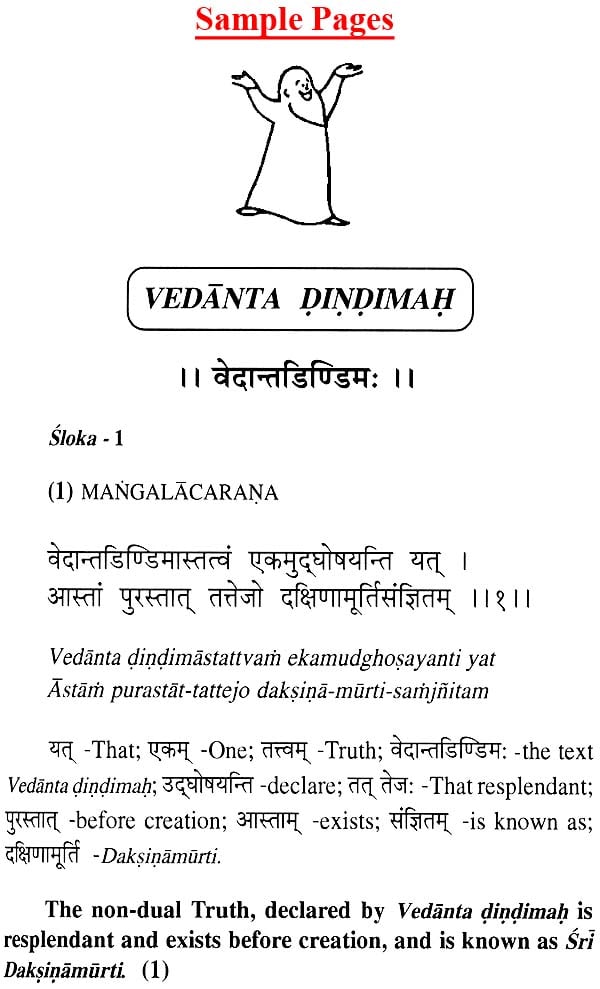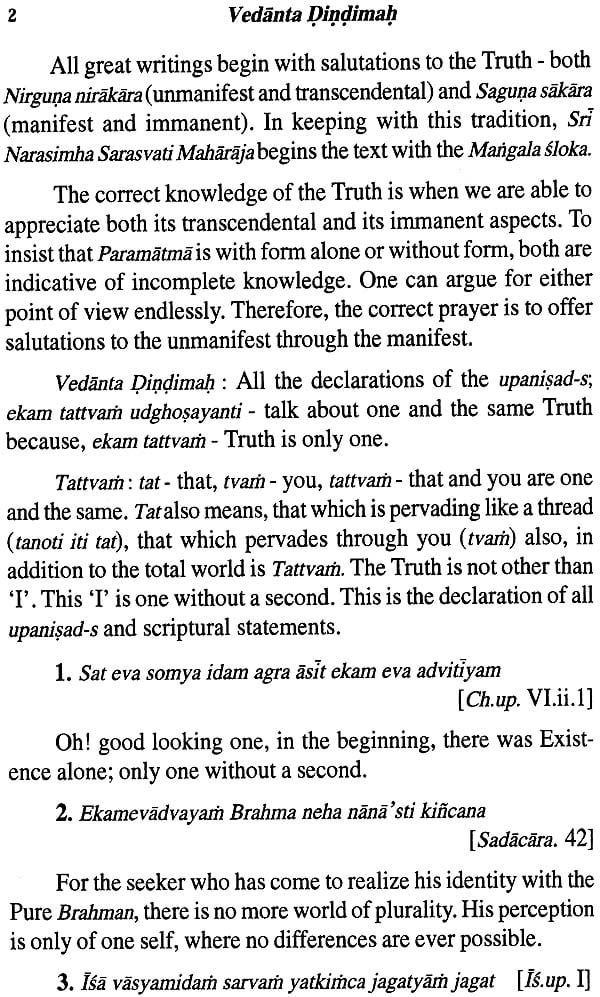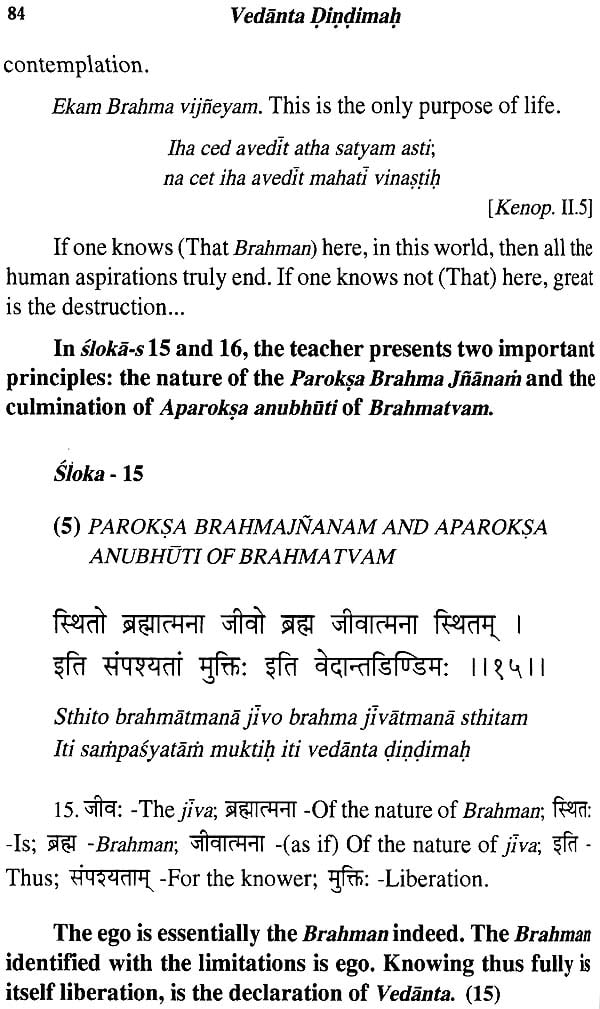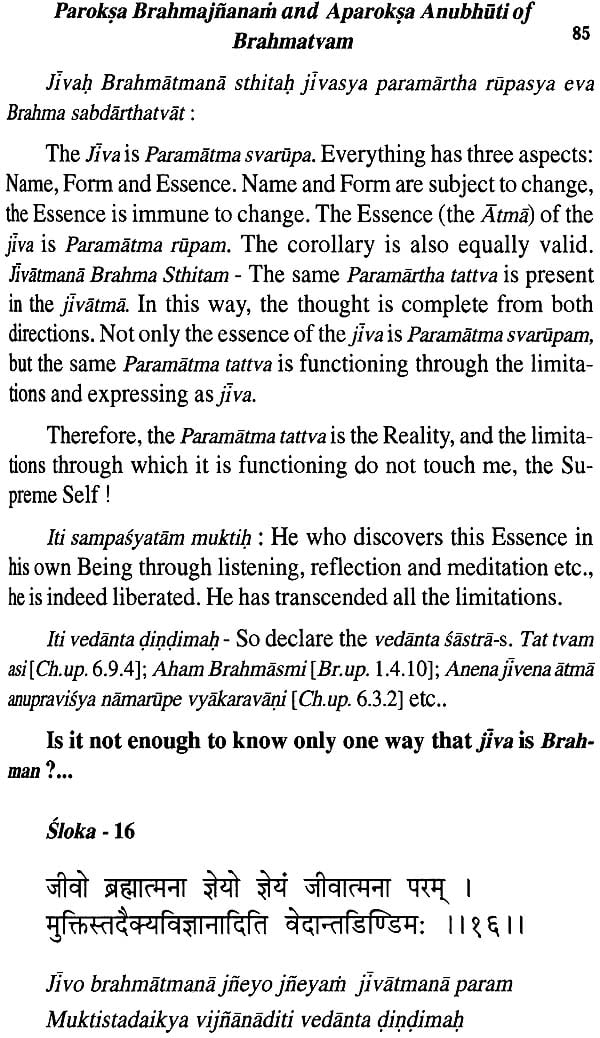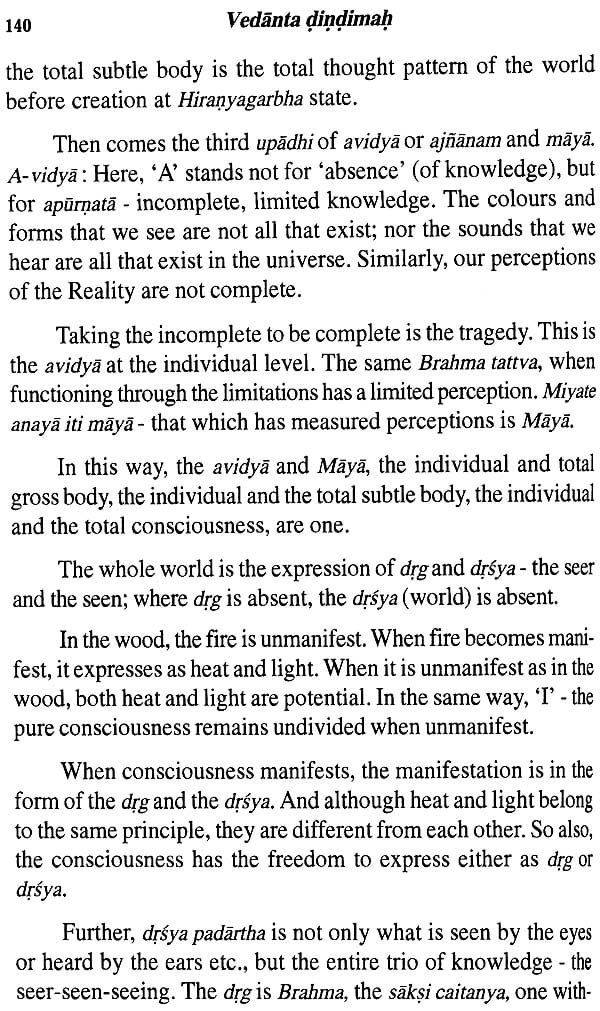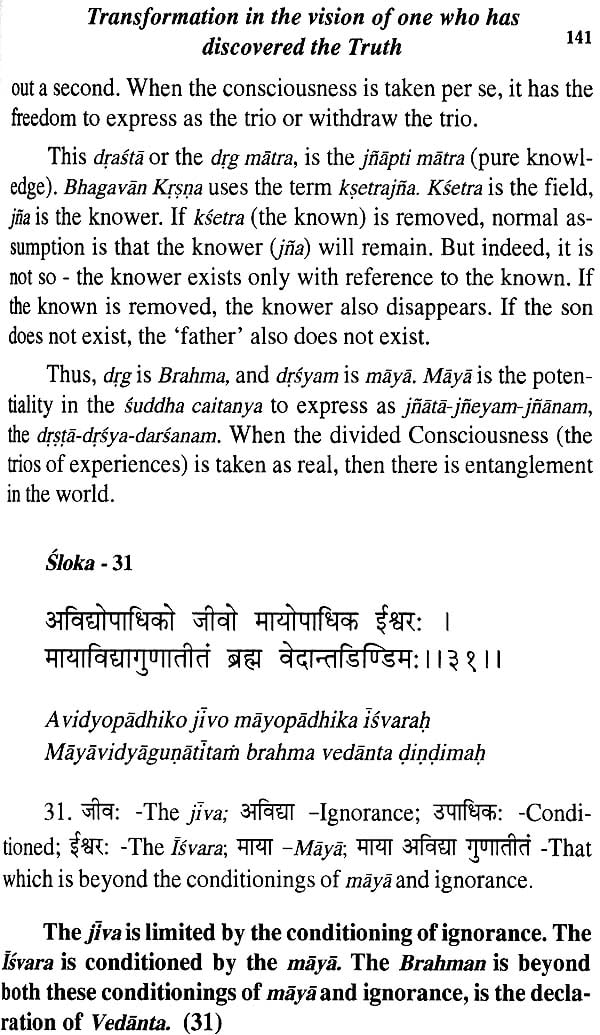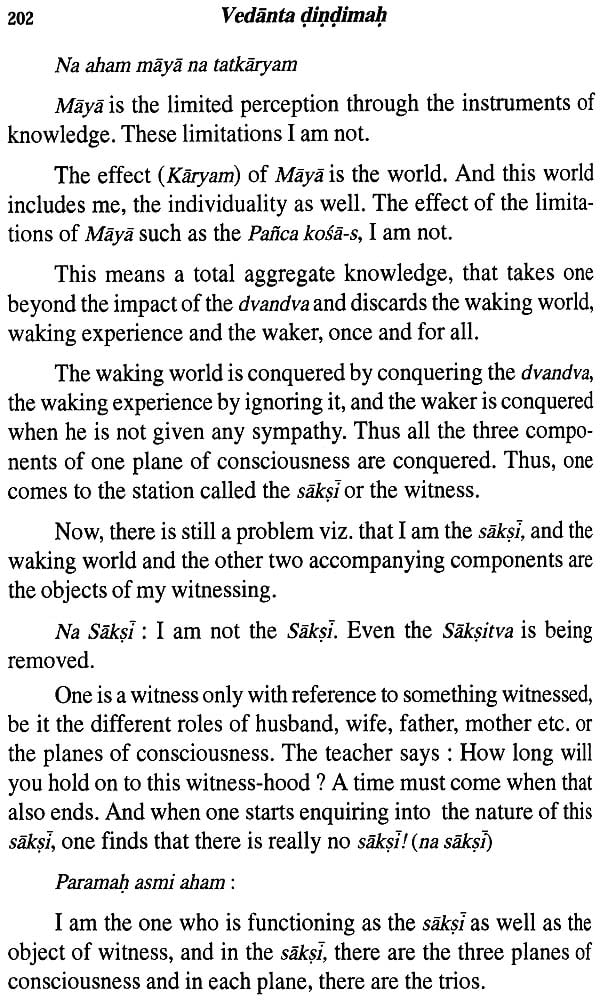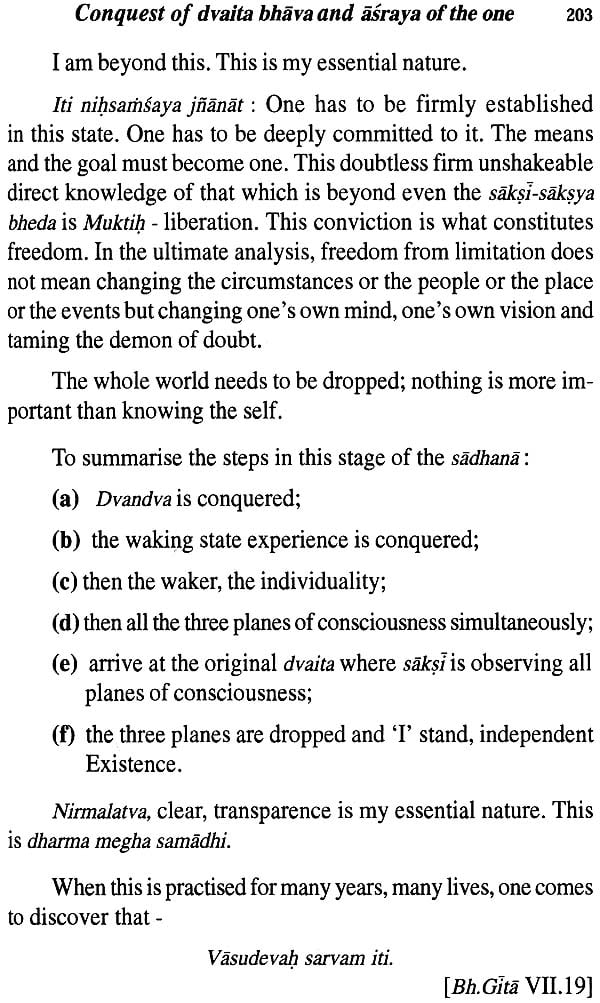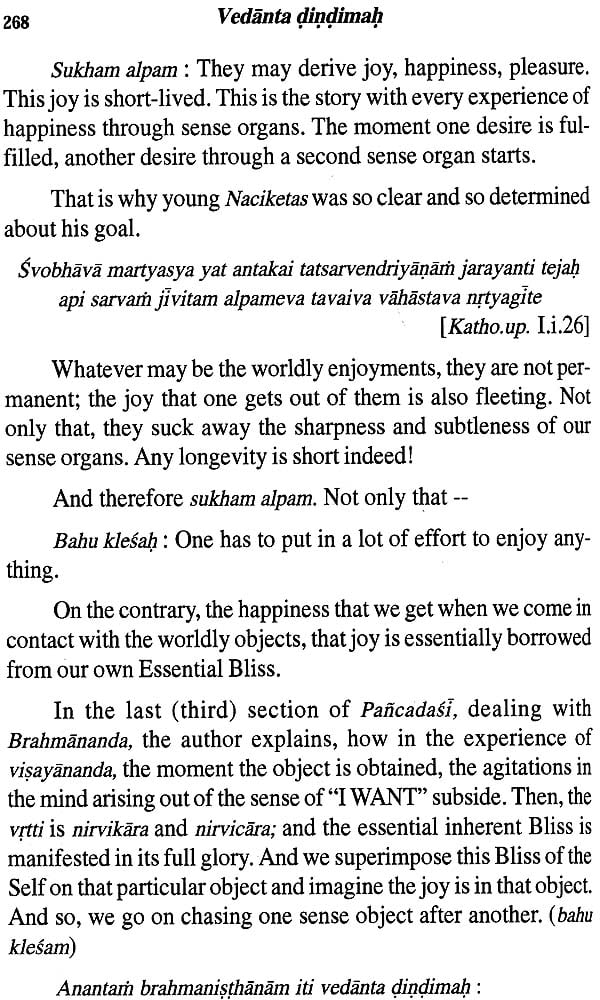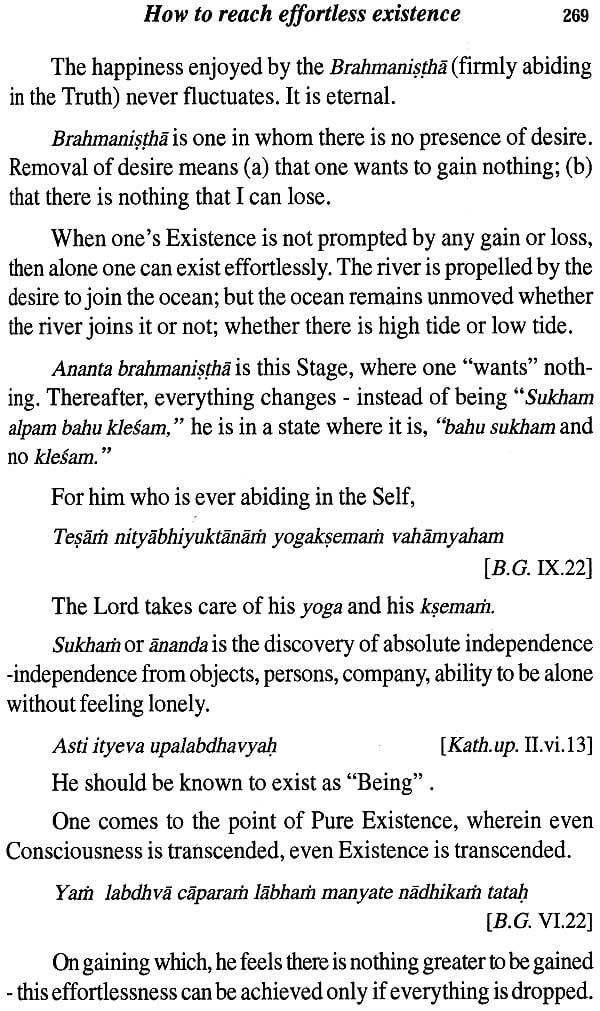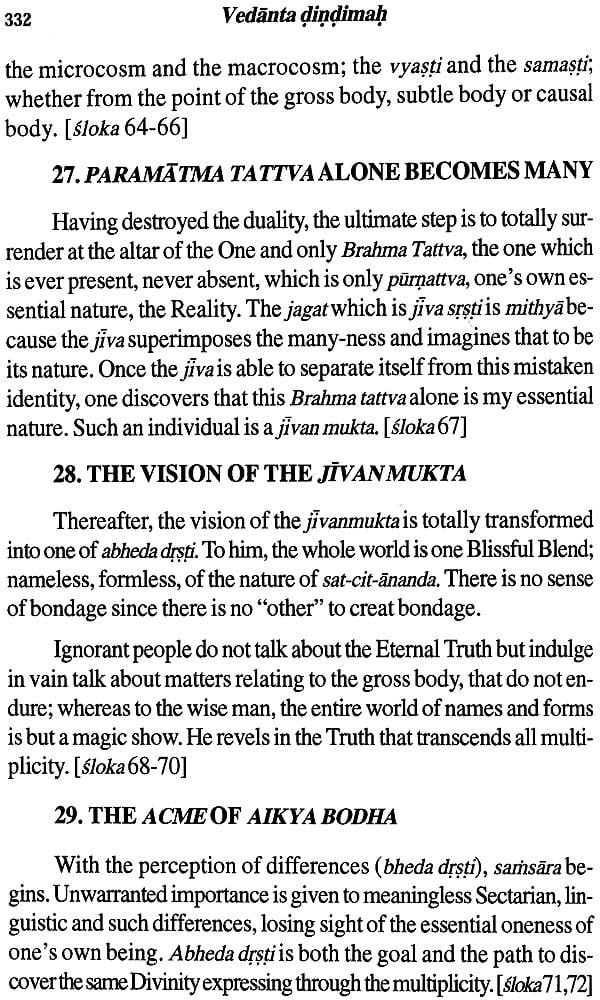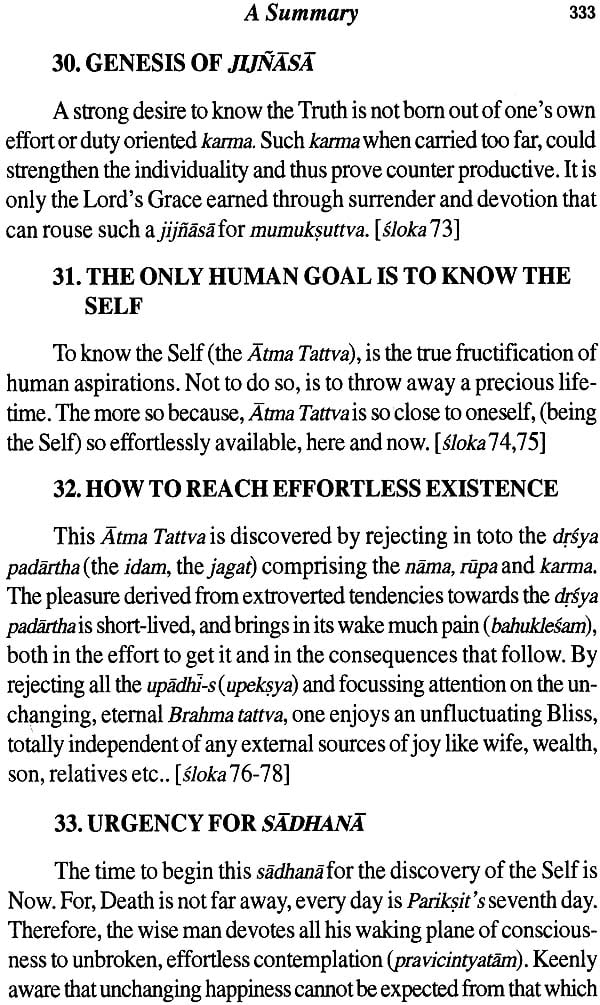
वेदान्तडिण्डिम: Vedanta Dindimah
Book Specification
| Item Code: | NAN812 |
| Author: | Swami Anubhavananda |
| Publisher: | INDRA PUBLISHING HOUSE |
| Language: | Sanskrit Text With Transliteration and Word-to-Word Meaning English Translation |
| Edition: | 2019 |
| ISBN: | 9789382518570 |
| Pages: | 344 |
| Cover: | Paperback |
| Other Details | 9.0 inch X 5.5 inch |
| Weight | 330 gm |
Book Description
This text is based on the discourses conducted in New Delhi from December 1992 - January 1993, extending over about seven weeks.
Vedanta dindimah is a text with a beautiful rhythm. It is a lightly packed, highly charged quintessence of vedantik thought. Almost all the topics of vedantik study are covered in these ninety-four sloks-s. There is a running link between one sloka and the next, a natural flow from one thought to another, taking the student from vedentik exposition to sadhana, and to the vision of the ultimate experience (Anubhuti). Not a word is out of place, not a syllable an idle one.
The discourses therefore, follow the pattern of : Detailed exposition of the text, unveiling layer by deeper layer of pregnant thought held in the womb of each word, phrase and sloks, followed by elaborate guidelines on how to transfer this understanding to one's own sadhana:
Since the theme of the text is to convey what the Sruti-s, the scriptures, the ultimate authority tell us about THE GOAL of human existence with all the force at one's command, every sloka ends with the sentence, "Thus declare the vedsms sastra-s." One who makes a technical study of the text would be expected to trace and study the various Upenisads etc. which echo the thoughts.
The purpose of the discourses being more in the nature of a Sadhana guide, and less a technical study, the quotations given are selective. Wherever possible, the text is quoted in full, with meaning. Sometimes, only the meaning is given and the reference is made to the original text.
It is but natural that such a reflective, sadhana -oriented study should every now and again glide into the subtler plane of meditation. These meditative thoughts which formed an integral part of the discourses, punctuate the text as and when they occur.
The student would do well to pause at each step, reflect and introspect on each idea, delve into its deeper import and ruminate on it. If so studied, even a word might trigger off the meditative mood, and one might glide into the inner silence, a thought-free fusion with the Etemal silence.
1. About the grantha (the text under consideration), Author, subject matter and greatness of the Vedanta sastra as expounded in this grantha to bring out the systematic theme development.
2. Analysis and the step by step and sloka (verse) by sloka grouping of the theme development.
3. Meaning of stuti pramana (authority of vedas), apourusheyatva (not created by human intellect) and the last authority in spiritual thought.
4. Thought development in veds-s and the value of it with reference to vedanta.
5. Importance of the studies of vadanta at the feet of the Teacher and the approach method.
6. Importance of Devotion to the Truth as God, Teacher and Scriptures. (Svetasvatara)
7. Story of Sri Daksinamurti and its reference in the text.
Prakarana Grantha-s :
There are different types of texts on different aspects of the Truth. Prakarana Grantha is one of them. These are texts which present in a popular way, that what is stated in technical and pregnant terms in the original texts, such as the Upanisad-s. This saves the student the trouble of searching in the depths of vedik and vedantik literature. The ideas are culled from the original texts in such a way that a coherent thought process can be developed. The student becomes familiar with different terms and becomes aware that such and such statement occurs in this or that source.
In fact, it can often happen that, after studying a few Prakarana Granths-s, when a student goes to the original texts, he feels that it is the Upanisad that has borrowed the thoughts from the Grantha-s!
The Author
It is a common belief that all vedantik texts have been written only by Bhagavan Sankara. The present text is one of the exceptions to that notion. It is attributed to a great Master called Sri Nrsimha Sarasvati, just as Drg Drsya Viveka is not attributed to Bhagavan Sankara but to Vidyaranya Svami based on the distinctive language and style of presentation.
The precise details of Sri Nrsimha Sarasvati's biography are not really known. But it is said that a great avatara of Lord Siva was born, around the 14th/15th century A.D., in the border area of the present Andhra Pradesh and Tamil Nadu. He was called Sri Sripada Vallabha. He was a siddha purusa from his birth. As a child, he was very quiet and never spoke. When he was seven or eight years old, he started to speak. Soon after, he left his parents' home and then disappeared. He was then born again in a place called Karanja lad; in Maharastra as Nrsimha Sarasvati. His parents were the upasaka-s of Lord Dattatreya. The Lord had blessed them in the dream that he would be taking birth as their son.
The child Nrsimha did not speak till he was seven or eight years old. His parents were worried thinking that he was perhaps dumb. Then he indicated to his parents that they should perform his upanayanam. As soon as that was done, he started reciting all the scriptures distinctly and clearly. He then declared, "Now I do not belong to you." He left home and travelled all over the country. He established three or four places of upasana of Lord Dattatreya
He is referred to in Sai Satcarita of Sirdi Sai Baba where the comparison is drawn as follows:
Sirdi sai Baba was a great Agnihotri or Karma Kandi. An Agnihotri is one who keeps the fire burning in the house and carries out all his vyavahara according to vedik injunctions. Sirdi Baba kept the agnikunda burning all twenty-four hours and that continues up to this day. Sri Nrsimha Svami was also a great Karmi i.e: one who lived according to the scriptural injunction. He was also a Sannyasi.
The Story is told in the book of Sri: Baba that once some devotees of Sri Sai Baba went to have darsan of Sri Nrsimha Svami at Nasik, and he asked them wherefrom they had come. When they said, "From Sirdi," he said, "Oh, you have come from my brother! Please give him this coconut with my Namaskara.
Sri Nrsimha Sarasvati was a prolific writer and has written a large number of vedantik books. To him is this text attributed. About this Text
This text consists of ninety-four sloka-s, and the striking feature is the refrain, "Iti Vedanta Dindimah that runs like a thread through all of them as the last line (carana). Let us now pause to understand the meaning of these two words, Vedanta and Dindimah.
Vedanta
Vedavta or upanisad means - where knowledge culminates. Vedanam antah vedantah- where does knowledge end? Knowledge begins from 'I', and ends in 'I'.
| Introduction | i | ||
| The Text | |||
| 1 | Mangalacarana | 1 | 1 |
| 2 | Definition of Vedantik Terms: | ||
| a | Atma Anatma Viveka | 2 | 7 |
| b | Jnana Anjana viveka | 3 | 11 |
| c | Jnata-Jneyam viveka | 4 | 15 |
| d | Sukham Duhkham Defined | 5 | 22 |
| e | Vyasti Samasti Defined | 6 | 30 |
| f | Jnanam and Karma Defined | 7 | 36 |
| g | Srotavya and Asravya Defined | 8 | 42 |
| h | Cintyam and Acintyam Defined | 9 | 50 |
| i | Dhyeya and Adhyeya Defined | 10 | 53 |
| 3 | Brahma Jnanam alone is Moksa | 11-12 | 58 |
| 4 | How Brahmajnanam manifests in the seeker | 13-14 | 65 |
| 5 | Paroksa Brahmajnanam and Aparoksa anubhuti of Brahmatvam | 15-16 | 84 |
| 6 | Brahma Atma akiya Bodha is simpler than the simplest | 17 | 87 |
| 7 | Karma vs. Brahmajnanam | 18 | 93 |
| 8 | Advaita vs Dvaita Vada | 19 | 97 |
| 9 | Limitations of Karma and Upasana | 20 | 102 |
| 10 | Karma vs Jnanam further defined | 21-22 | 105 |
| 11 | Reaching the Goal of Brahmavijnanam is of Primary Importance | 23-25 | 114 |
| 12 | Karma and Upasana have their role in Spiritual Sadhana | 26-29 | 124 |
| 13 | Transformatio in the vision of one who has discovered the truth | 20-31 | |
| 14 | Nature of Brahman | 32 | 145 |
| 15 | Three steps on the spiritual path | 33 | 147 |
| 16 | The World is Nothing but Brahman | 34-36 | 149 |
| 17 | The technique of Discovering the Truth | 37-155 | |
| 18 | Mithyatva of Jagat and Satyatva of brahman | 38-39 | 162 |
| 19 | Moksartha is the Highest Goal | 40-167 | |
| 21 | Saksi Bhava Sadhana with reference to oneself | 43-48 | 186 |
| 22 | Conquest of dvaita bbhava and Asraya of the one | 49-50 | 21 |
| 23 | Suvarna Buddhi vs. Alankara Buddhi | 51-53 | 206 |
| 24 | Brahmatattva and the pancamahabhuta-s | 54-59 | 213 |
| 25 | Establishment of identity between Jivatma and paramatma | 60-63 | 220 |
| 26 | Absence of Bheda between jiva and Brahman | 65-66 | 226 |
| 27 | Paramatma Tattva alone becomes many | 67 | 231 |
| 28 | The Vision of the Jivan Mukta | 68-70 | 235 |
| 29 | The Acme of Aikya Bodha | 71-72 | 245 |
| 30 | Genesis of Jijnasa | 73 | 253 |
| 31 | The Only human goal is to know the truth | 74-75 | 257 |
| 32 | How to reach effortless Existence | 76-78 | 264 |
| 33 | The urgency for Sadhana | 79-80 | 273 |
| 34 | One's Essential Nature is Bliss | 81-84 | 278 |
| 35 | Anuloma -Pratiloma Prakriya | 85 | 293 |
| 36 | Bheda Abheda Drsti Redefined | 86-87 | 299 |
| 37 | "Abheda Drsti and after | 88-89 | 302 |
| 38 | Role of Prarabda and other Karma-s in the wise man's life | 90-92 | 307 |
| 39 | This is the sruti Bheri | 93-94 | 314 |
| Summary | |||
| (The Flow of Thought in the Text) | 319 |
